T-Force Delta RGB DDR5-6400 Review: 285K Memory Mastery?
What’s in an overclock? Excessive voltage would be a nonstarter for us, as the performance gains are too small to justify putting any of our hardware at moderate risk. We’ve already seen a flurry of dead processors from both AMD and Intel that show a small heat blister form beneath the memory controller in the tiny circuit board to which the CPU core is attached: As those failures continue to lend credence to our theory of using relatively low voltage limits in our overclocks, we can only wonder how much farther we could be pushing things if we only intend our parts to last through a typical three-year or five-year upgrade cycle. Sensing our caution, TeamGroup responded to our 285K memory overclocking intro not by sending us its fastest memory, but instead by sending a set of its best-value 1.35V performance DIMMs. These are the 32GB kit of its T-Force Delta RGB DDR5-6400.
| T-Force Delta RGB 32GB (FF3D532G6400HC40BDC01) | |
| Capacity | 32 GB (2x 16GB) |
| Data Rate | DDR5-6400 (EXPO, XMP) |
| Primary Timings | 40-40-40-84 (2T) |
| Voltage | 1.35 Volts |
| Height | 46mm |
| Warranty | Lifetime |
| Price When Tested | $86.00 |
Each Delta RGB DDR5 32GB kit includes two 16GB modules and a Mylar (or similar material) sticker, so you’ll have to go to the kit’s web page to read about the limitations of its lifetime warranty: As of this writing, the linked content reads “Replacement service is available at no cost for non-human damages”, which means that if you don’t manually fry it or physically break it, they’ll replace it. That’s far less restrictive than any other limited warranty description that we’ve read from other brand!

Since the warranty excludes human damage, we didn’t attempt to peel the heat spreaders but instead relied on our motherboard’s firmware to report that the kit uses Hynix IC’s. All eight ICs are on one side of each 16GB module, whereas 32GB modules (for 64GB kits) would have both sides filled: To allow the same-thickness heat spreader to fit both module types, TeamGroup adds a strip of foam tape to the blank side of each 16GB module.
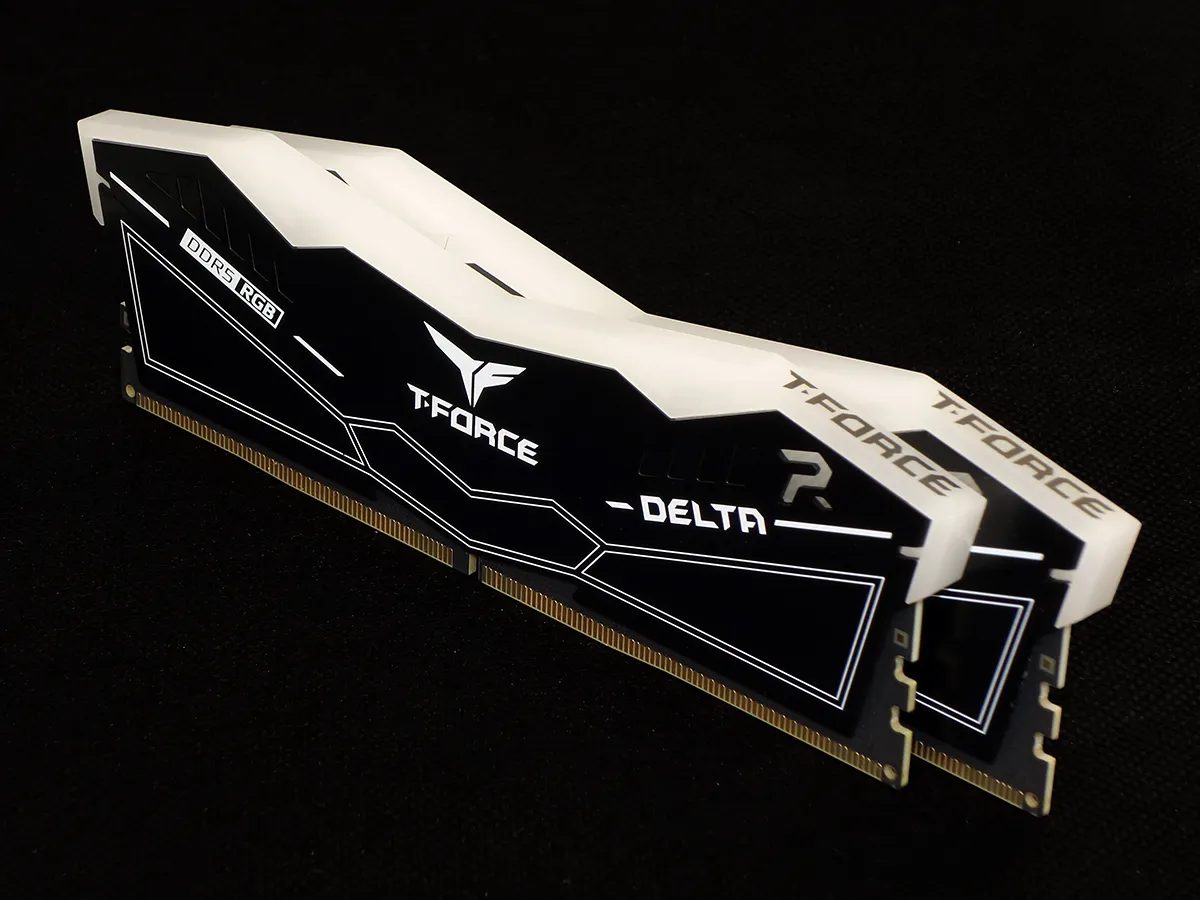
As the Delta RGB DDR5-6400 kit’s rated performance level is an XMP profile, our motherboard treated it as DDR5-5200 until we initiated a single setting in our motherboard’s firmware to enabled its first XMP profile. Those who find that their motherboards are unstable or unable to provide the voltage needed to use the DDR5-6400 XMP will find a slower DDR5-6000 backup XMP, and AMD users will find EXPO alternatives at the same data rates and primary timings.
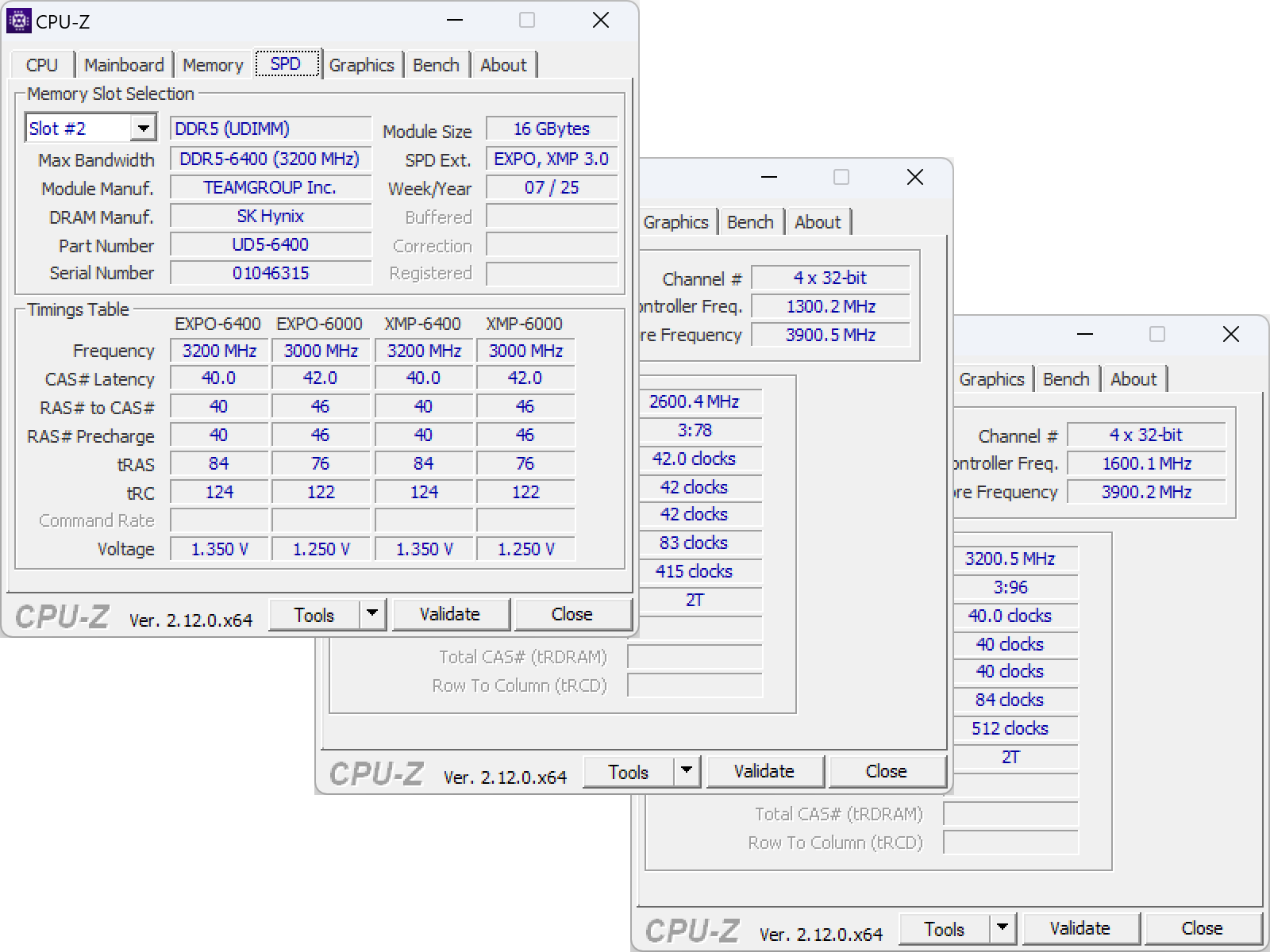
Our motherboard’s RGB suite was completely able to manage T-Force Delta RGB memory lighting, but decoupling it from our ASRock graphics card did open up a few additional lighting modes.


Each DIMM appears to have eight RGB LEDs, though TeamGroup’s diffusor works well enough that we weren’t quite certain of this.

T-Force Delta RGB Test Configuration
We’re using Intel’s excellent Core Ultra 9 285K to push each kit’s maximum stable 1.35V data rates on ASRock’s similarly capable Z890 Taichi Lite.
| Test Hardware | |
| CPU | Intel Core Ultra 9 285K: 24 Cores, 36M Cache, 3.2- 5.70 GHz, LGA 1851 |
| CPU Cooler | Alphacool Core 1 Aurora CPU, VPP655 with Eisbecher D5 150mm, NexXxoS UT60 X-Flow |
| Motherboard | ASRock Z890 Taichi Lite, BIOS 3.04 |
| Graphics | ASRock RX 7700 XT Phantom Gaming 12GB OC |
| Hard Drive | Crucial T700 PCIe Gen5 2TB M.2 SSD |
Delta RGB Overclocking
Though the updated BIOS helped, the motherboard showed us the path towards exceeding DDR5-7200 data rates on some modules, without breaking our self-imposed 1.35V limit: We had to add the 1.35V setting in more places! To be precise, one of its firmware’s built-in profiles showed us to increase VDD2, Vdd2Mv, Vddq, VDD, and VDDQ to various levels between 1.35V and 1.45V, and we simply backed the 1.40-1.45V values down to 1.35V to comply with our previous safe-settings.
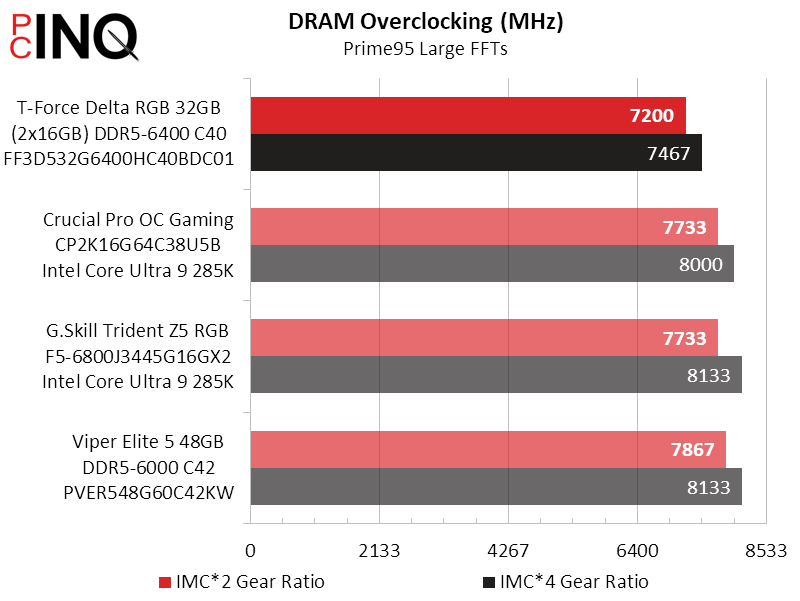
Unfortunately, while the board showed us the way forward, the Delta RGB kit held us back. It was only the other kits that reached DDR5-7733 or above.
| Lowest Stable Timings | |||
| DDR5-6400 | DDR5-5600 | DDR5-4800 | |
| T-Force Delta RGB 32GB (2x16GB) DDR5-6400 C40 FF3D532G6400HC40BDC01 | 34-38-38-76 (2T) | 28-33-33-66 (2T) | 26-30-30-60 (2T) |
| Crucial Pro OC Gaming CP2K16G64C38U5B Intel Core Ultra 9 285K | 34-37-37-74 (2T) | 34-32-32-64 (2T) | 32-28-28-56 (2T) |
| G.Skill Trident Z5 RGB F5-6800J3445G16GX2 Intel Core Ultra 9 285K | 32-38-38-76 (2T) | 28-33-33-66 (2T) | 24-28-28-56 (2T) |
| Viper Elite 5 48GB DDR5-6000 C42 PVER548G60C42KW | 32-38-38-76 (2T) | 28-33-33-66 (2T) | 24-28-28-56 (2T) |
The Delta RGB also fell slightly behind as we sought the quickest latency, though the slower we set its data rate the more competitively we could adjust its timings.
Benchmark Results
Most users won’t manually overclock their memory, and the Delta RGB is nearly as fast at the Pro OC Gaming kit when both are tested at XMP values. The Trident Z5 RGB is 50% pricier than either of those kits, and the Viper Elite 5, while also being 50% pricier than the T-Force or Crucial kits, comes with 50% more capacity.
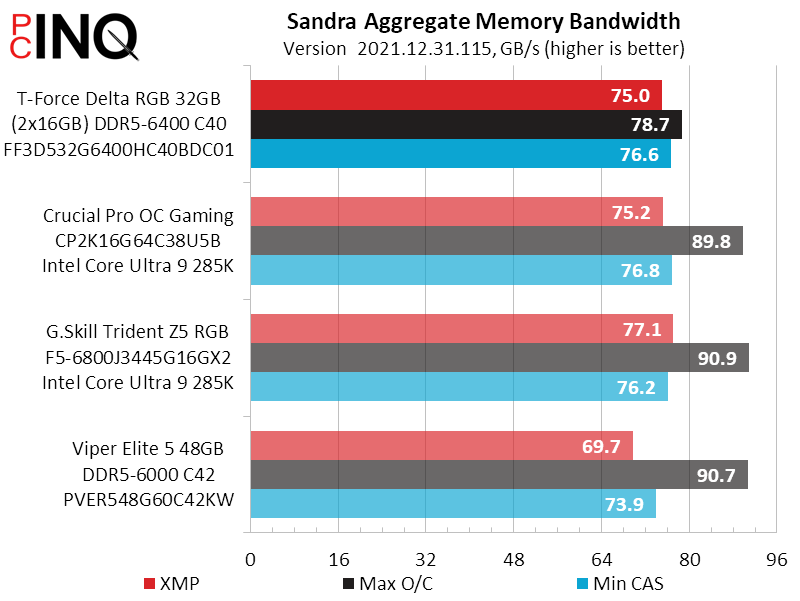
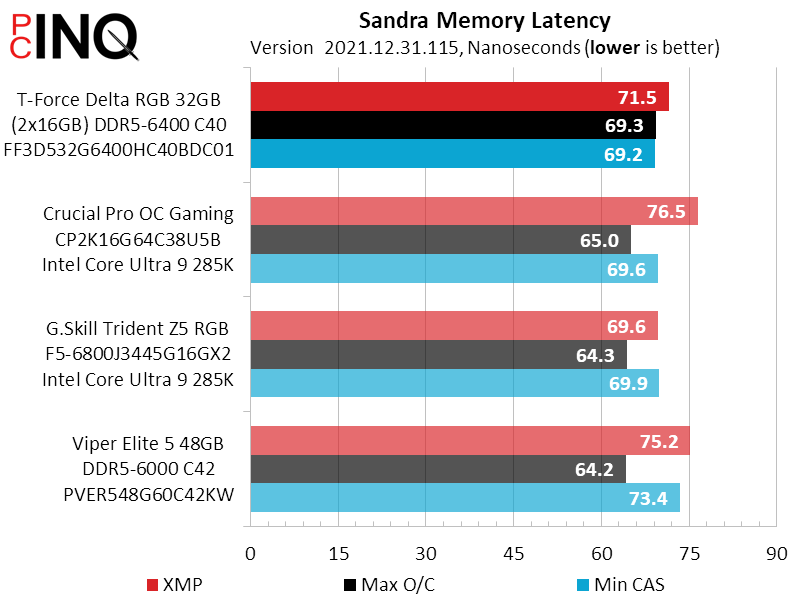
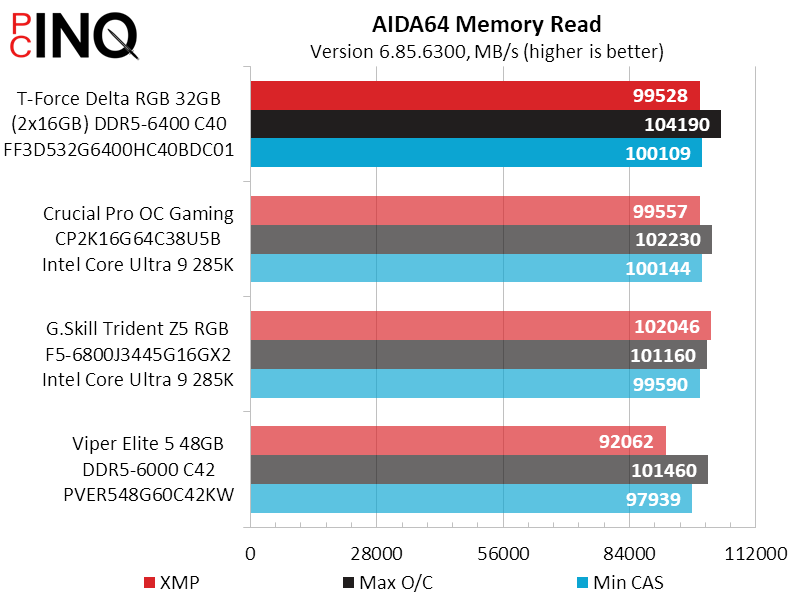
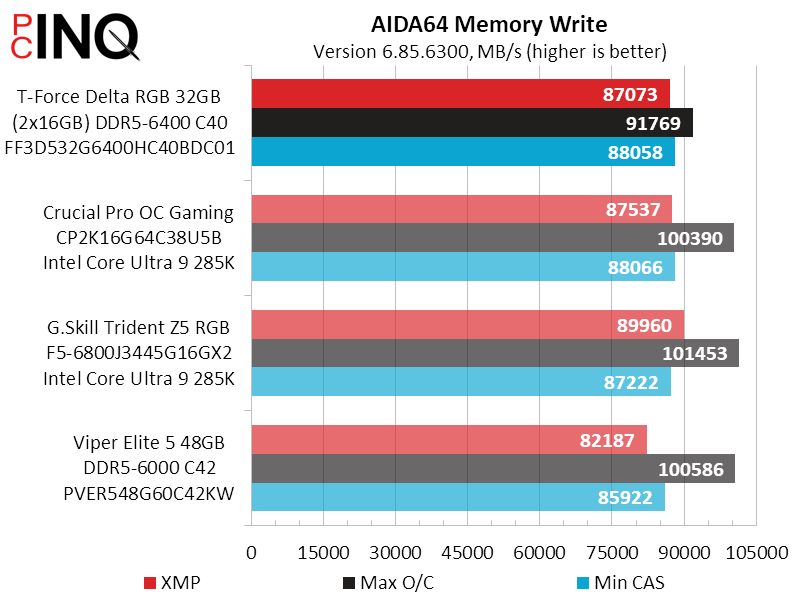
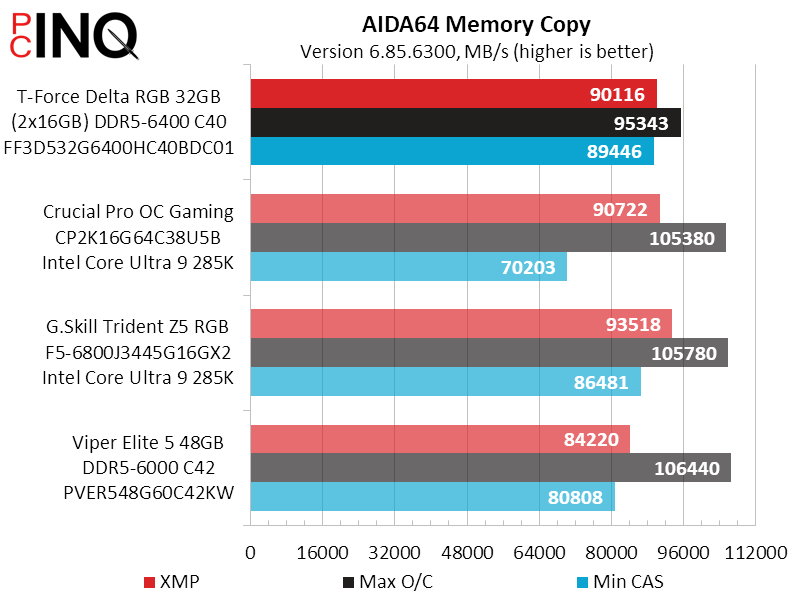

Once again, if we stick with just the XMP settings Delta RGB is capable of carrying its weight through all of 3DMark’s tests.

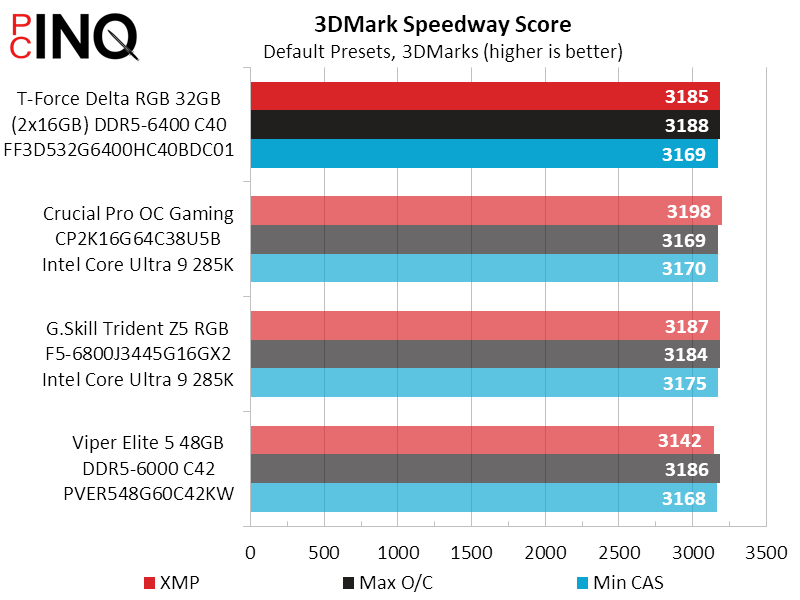
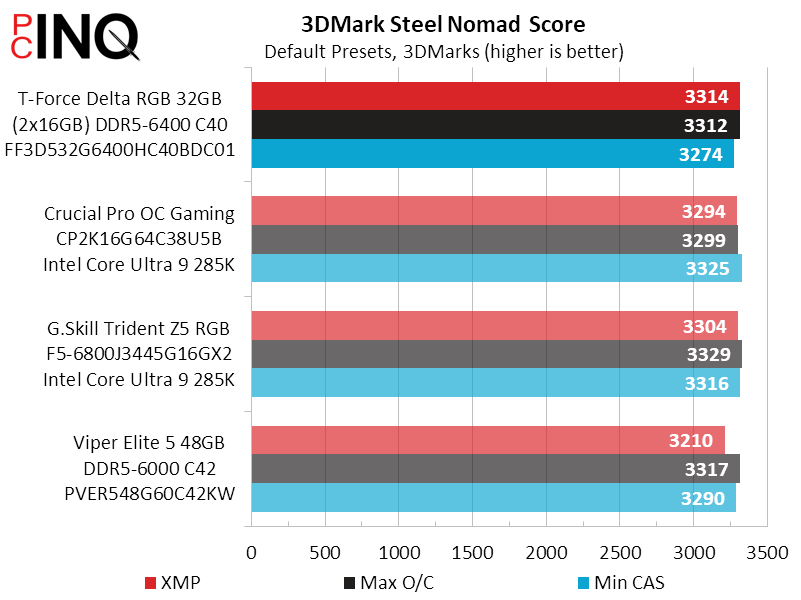
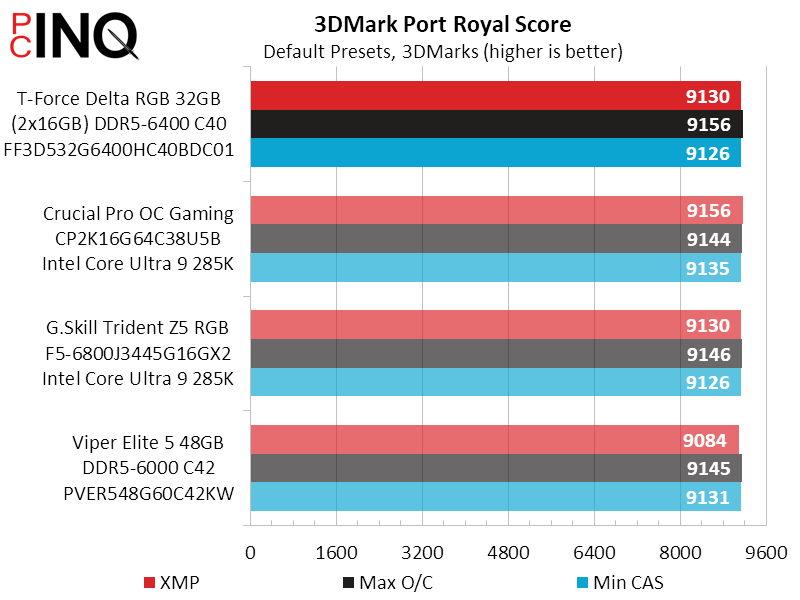
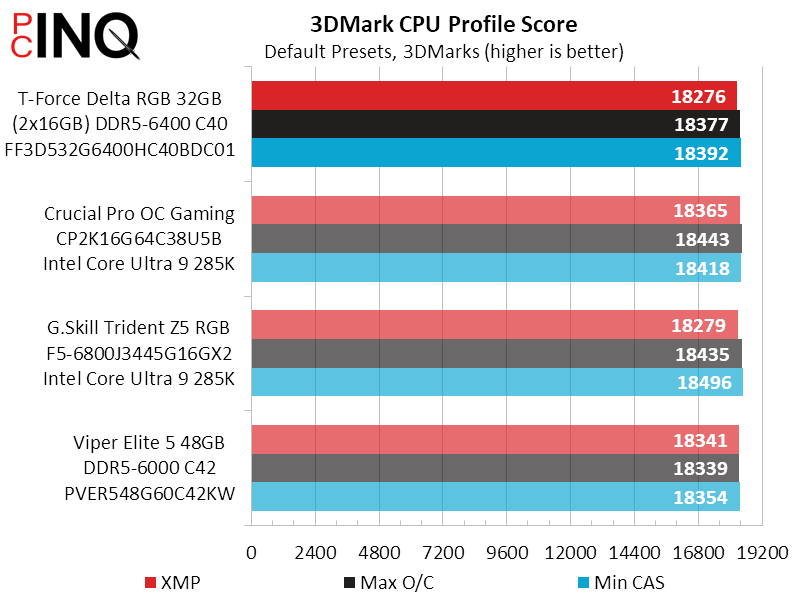
We keep forgetting to remove Unigine from our DRAM test suite, but thought we’d include the data since we generated it. There’s not much to see regarding memory impact.


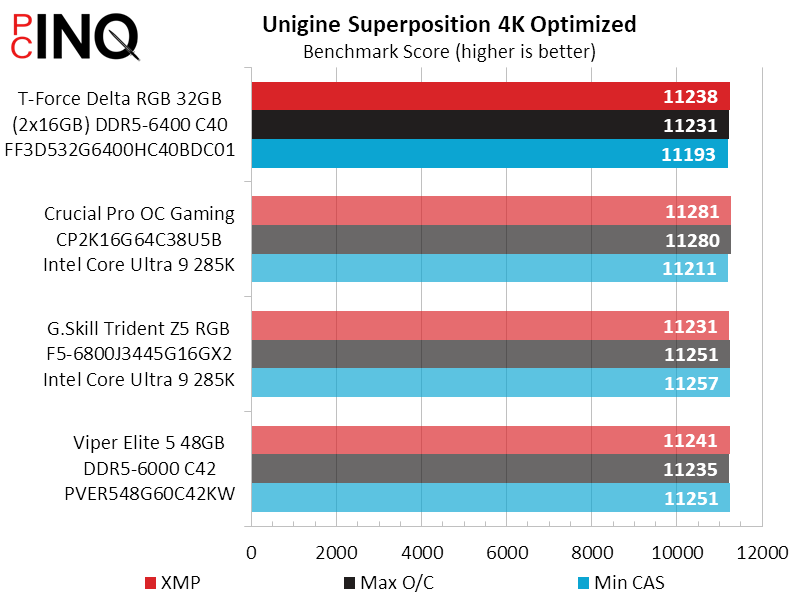
F1 2021’s EGO engine is very much impacted by memory performance, but only to a certain point: We crossed that point several years ago at DDR4-3600. An updated CPU and graphics card gets it closer to the limits of DRAM performance, but the noticing difference between DDR5-6000 and DDR5-6800 remains a futile exercise.

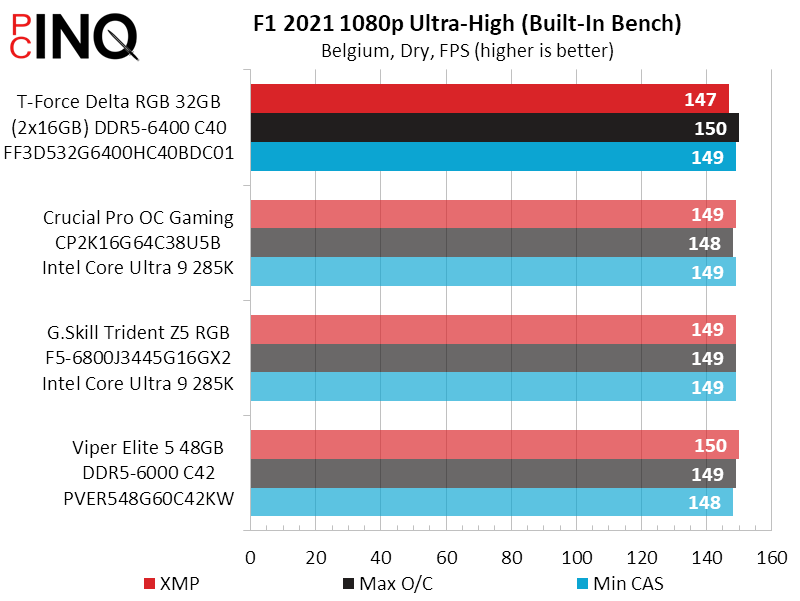
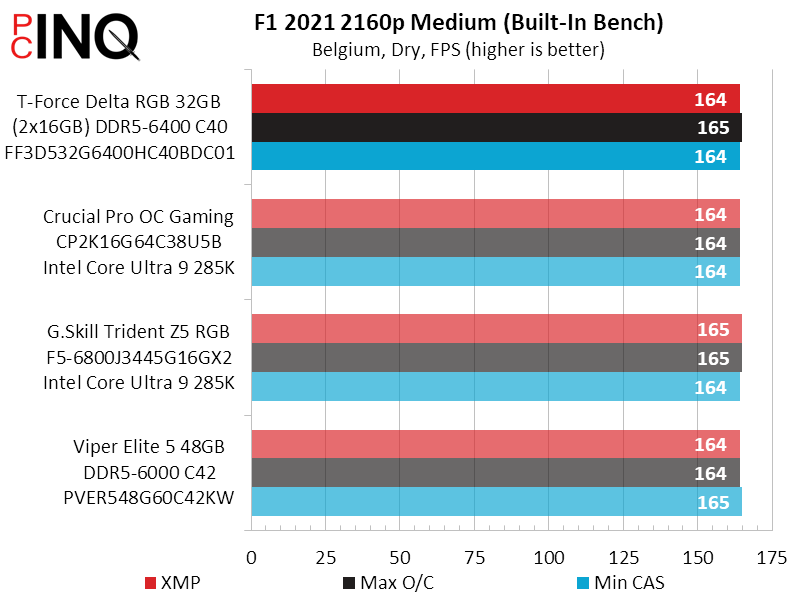

CyberPunk doesn’t show much difference, but SOTR might be useful to those who don’t mind using medium settings to create visible differences.
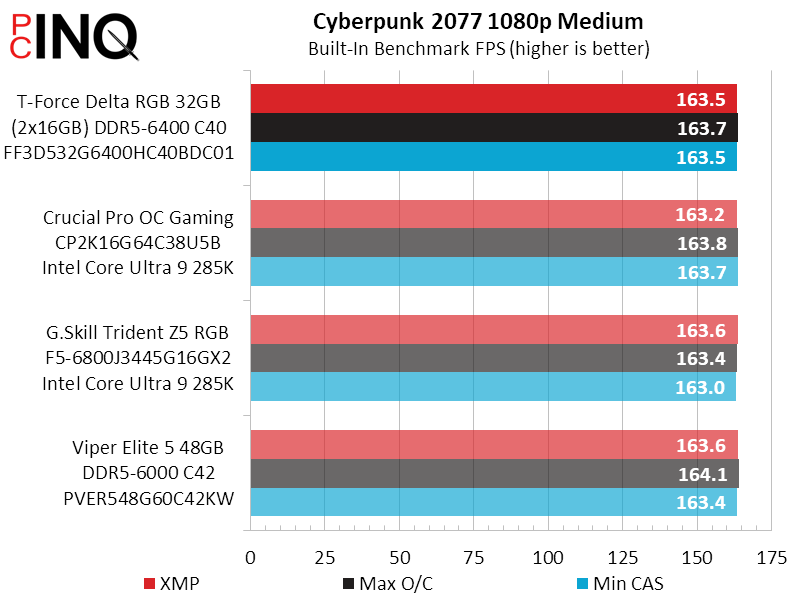
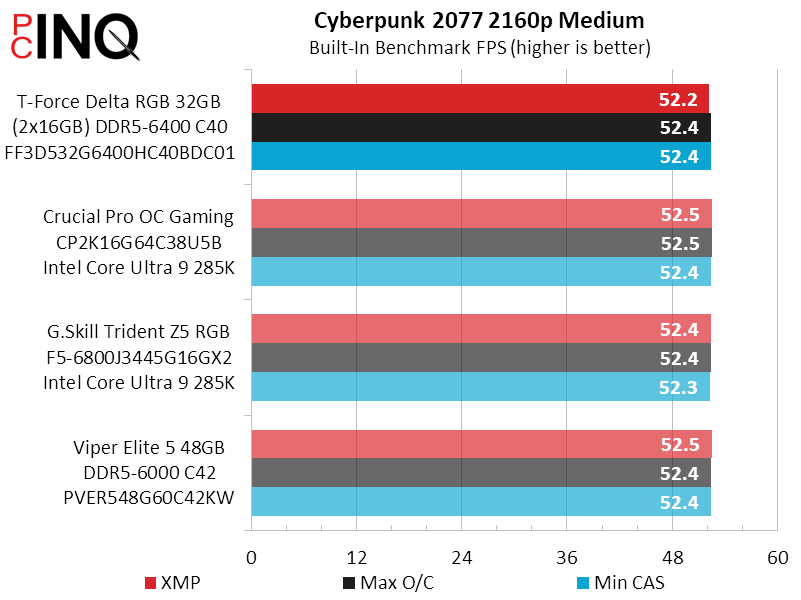

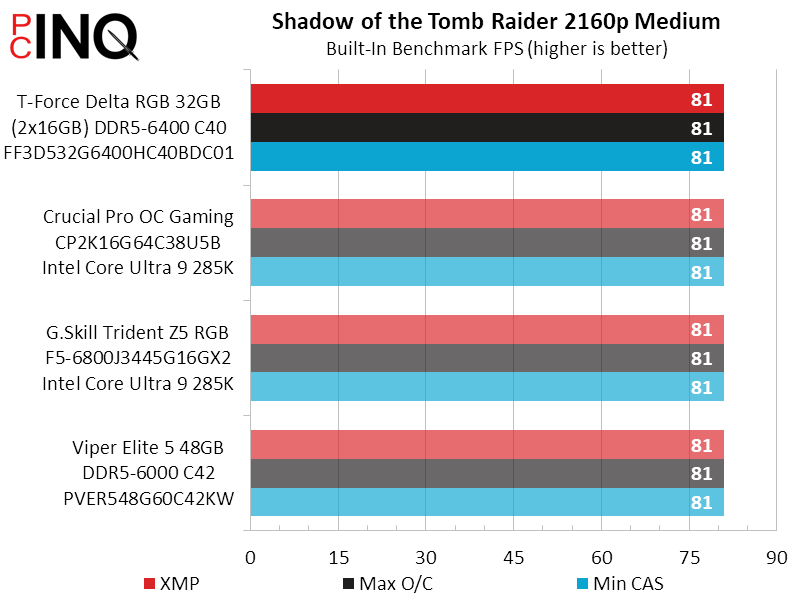
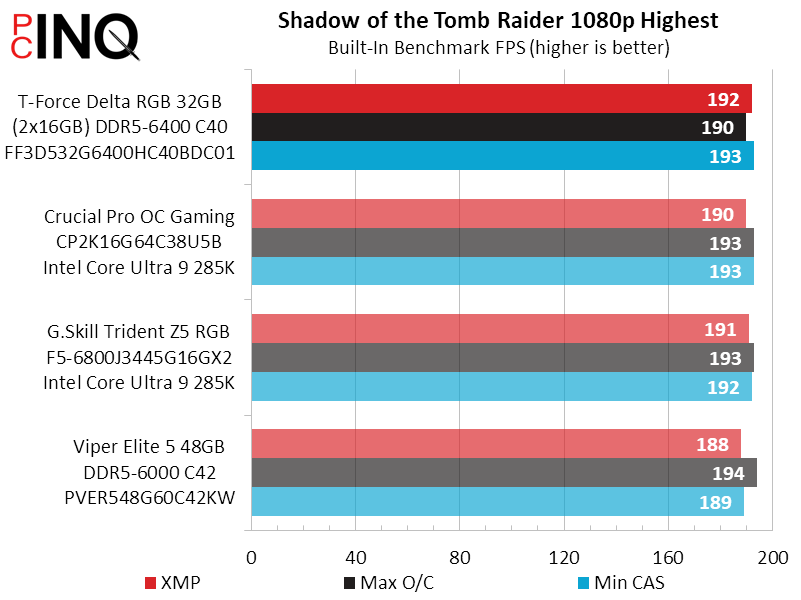

Surprisingly, 7.Zip Synthetic test shows overclocking the Delta RGB a worthy pass-time. It still loses to all overlocked competitors in our real-world timed test, however.


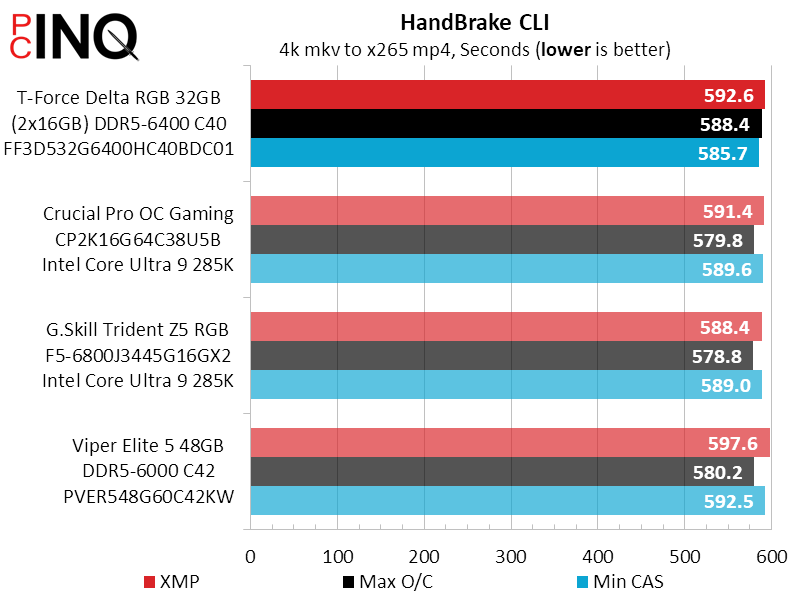
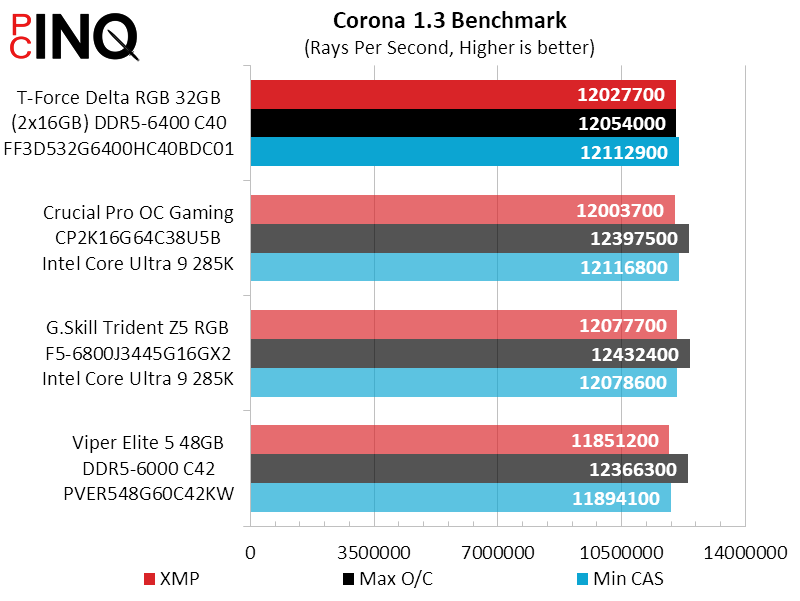
In the end, XMP performance is what keeps the Delta RGB in the running, and that’s only because most builders will do nothing more to overclock their DIMMs than to enable the kit’s XMP or EXPO profile. The Delta RGB’s XMP performs almost identically to the Pro OC Gaming’s, and both kits are within a $1 difference of each other.

If we were choosing a sub $90 kit for a system that we’d never manually overclock, the choice between Delta RGB and Pro OC Gaming becomes purely aesthetic. And since the Pro OC Gaming already received an award for its XMP performance, treating the Delta RGB similarly for providing similar performance could have meant giving it the same award. But we need no be that repetitive: Equal to our prior award winner in XMP performance, today’s pricing makes the T-Force Delta’s nearly free RGB a value choice for those who would otherwise be willing to pay for that feature.

| T-Force Delta RGB model FF3D532G6400HC40BDC01 | |
| Pros | Cons |
| Includes XMP and EXPO Top XMP performance Includes RGB at zero added cost | 46mm height may interfere with some CPU coolers |
| The Verdict | |
| Buyers who waffled over its closest competitor’s lack of RGB will love that the Delta RGB FF3D532G6400HC40BDC01 kit has it for only $1 more. | |
Find it at Amazon

(click for availability)
